Four Graves At Ynyscynhaearn
Gary Hill
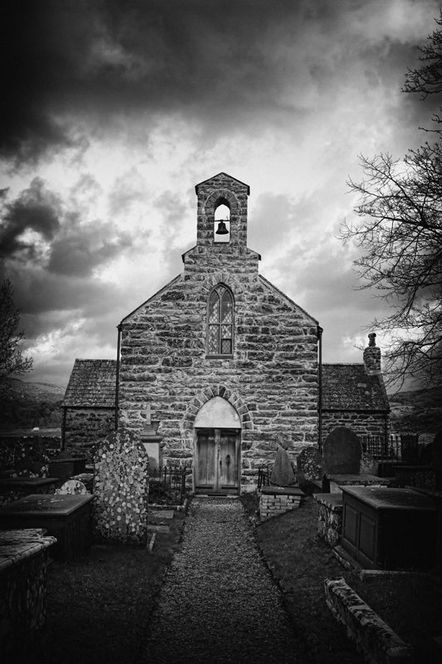
•A Brief History Of The Church•
About a kilometre from the main road in a roughly southerly direction from the village of Pentrefelin in Gwynedd, Wales, along an ancient causeway that hugs the side of a hill across the farmland of Bron Y Gadair, in the direction of the sea, sits a small church dedicated to the Celtic saint Cynhaearn. This is a place I visit occasionally when I feel a need for solitude but have little time to walk or drive somewhere more remote. The church of St Cynhaearn, more commonly known as Ynyscynhaearn, rests in peace, alone, leaning slightly to the right, and surrounded by the sleeping graves of more than three centuries worth or more of parishioners. Nothing much happens here today. I imagine if they were to awake and cast their eyes around the churchyard, it would be as if they had never slept.
Regular services ended in 1983 and the church is now ‘redundant’ but remains consecrated and should always be so, lest it bear the ignominious fate of a large private home, or worse still, holiday cottages. Thankfully, it is designated by Cadw as a Grade II* listed building and since 2003 has been in the care of the Friends of Friendless Churches. Beyond the stone walls of the graveyard in three directions are the low-lying lush green fields that were once filled with water (hence the prefix ‘ynys’, or island), for the land used to be an inlet from the sea which became isolated when a shingle bank formed. The reclaimed land is now dotted with not quite white sheep. Facing the main church door is the small hillside on which the causeway hangs. The atmosphere here is always one of a wonderful quietness, for few people or vehicles venture this far down the narrow track.
For me, the history of this place is not one that is best gleaned from a textbook or a lecture followed by a visit forearmed with the knowledge of what to see. I knew nothing of this place before my first visit, save that it was a very old church, recommended to me by an acquaintance for no other reason than “you like hangin’ out in old churches”. I have since been surprised by the number of local people, especially those younger, who have not heard of this place. The sense of history here was palpable from the moment I entered the stone and well-worn wood lychgate to view the slate gravestones, orphaned from their corpses and lined up along the side benches. There is something about the immediacy of the sense of history in rural Wales and Ynyscynhaearn is no exception. The past can be breathed in here if you close your eyes, be still and listen. You might imagine the gallop of hooves and the voices of the old Welsh tongue in the surrounding air that is rarely still, but passes by, sometimes gently, too often ferociously.
Little is known of Cynhaearn ap Cynwel. It is believed he was a fifth (some say sixth) century monk who established Christianity and the first known church in the locality historically known as Tre’r Gest (roughly the area between the modern towns of Porthmadog and Criccieth). His brother Aelhaearn is associated with the village of Llanaelhaearn on the Llŷn Peninsula, some twenty kilometres away. The foundations of Ynyscynhaearn church are believed to date from the 7th century and the nave is from the 12th century. The earliest written records, from the 16th century, tell us that the north transept was added sometime in the 16th century and the south transept in the early 17th century. A carved wooden cherub, also believed to be 17th century, sits over the main, west door.
It is not known why Ynyscynhaearn was built on a small island completely surrounded by an inland lake, though it is likely that the banks of Llyn Ystumllyn (the tautologously named ‘lake of the meandering lake’) harboured an early settlement, evidence of which has long since gone. The church served continuously as the parish church for Tre’r Gest until the early 19th century when it fell into such disrepair that it was abandoned for a time, being rebuilt in 1832. It is recorded elsewhere as being a resting place for early Christian pilgrims making their way to Ynys Enlli, a small island just off the westernmost tip of the Llŷn Peninsula considered to be “the holy place of burial for all the bravest and best in the land" and "the land of indulgences, absolution and pardon, the road to Heaven, and the gate to Paradise”. A number of Celtic saints are buried on Ynys Enlli, which was known also, with considerable hyperbole, as the the isle of 20,000 saints. In medieval times three pilgrimages to Enlli were considered to be the equivalent of one pilgrimage to Rome.
The current building is predominantly made from long flat stone rubble with a stucco finish for the walls of the nave and the east side of the chancel. Today, the interior tends toward plain, predominantly in the Georgian style yet overlaid with some Victorian decorations made possible by the new wealth brought to the parish in the mid-19th century by nearby slate quarries and associated railways and shipping concerns and the creation of the nearby town of Portmadoc (now called Porthmadog). This change of fortune was not limited to the church decor, however. Records show that the Rev. John Jones performed regular services (in English only) unpaid between 1823-1856 but his successor, Rev. David W Thomas, was able to be paid.
A number of interior features deserve mention. The octagonal pulpit, set against an architraved and corniced backboard and installed during the rebuild, is considered to be one of the most magnificent in Wales. It has three-decks, approached by nine steps, a second tier lectern with reading shelf and underneath a desk for those giving the readings. Stained glass windows were installed in 1899 and 1906 by Powell and Sons. One, on the north-facing wall of the church, depicts St. Cynhaearn with boat and oar in reference to the location of the church surrounded by the waters of Llyn Ystumllyn. The east-facing window is a memorial to Lieutenant-Colonel Isaac Walker and his wife Louisa Walker, late of Lincolnshire, England and Hendre Gadraeth, Pentrefelin, who purchased the barrelled chamber organ from the parish church at nearby Tremadoc (now Tremadog) in 1854 for £30 (equivalent to £2,481 in 2011; apparently it was not loud enough for the much larger Tremadoc church). The Walkers made a wise purchase. The organ had been originally purchased for ten times that amount about 45 years earlier by lawyer and landowner David Ellis-Nanney, a former Attorney-General for North Wales. Having been constructed by Flight & Robson of 101 Martin’s Lane, London, the organ has a sound pedigree. Although the original company of Flight & Robson went into liquidation in 1832, George Robson, later joined by his son Thomas, was responsible for many progressive designs for organs around this time fitting, for example, Corpus Christi, Cambridge in 1830 and Queens University, Belfast in 1857.
Lieutenant-Colonel Walker died in 1862 and has been honoured by a limestone Gothic aedicule on the north side of the church. The Walkers have been described as “English to the core”, but Mrs Walker appears to have learned the local language as her well-thumbed Welsh prayer book, still kept in the church, attests. On each side of the organ are six box pews one step high. These were labelled by family name on each end and seated members of the gentry and larger land-owning families from estates such as Cefn-y-Maesydd Isaf, Cefn-y-Maesydd Uchaf, Penamser and Steddfa. In the main part of the church lie some ordinary pews for their servants and one pew was always kept curtained off for mothers to feed their babies.
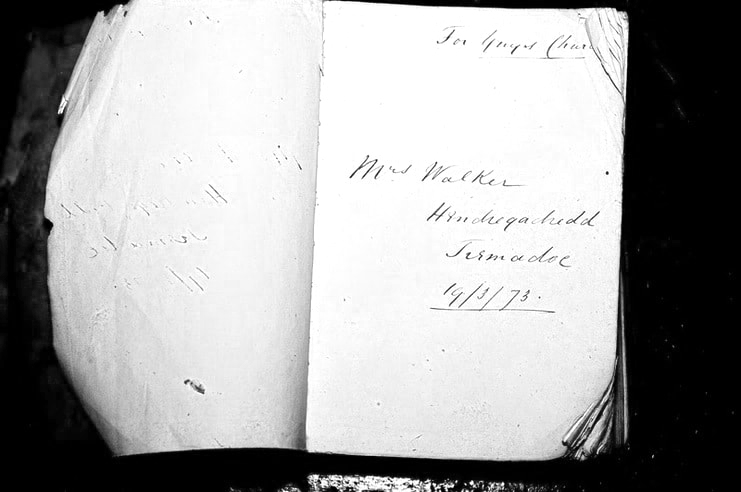
During the 18th century two parishioners approached the Bishop of Bangor with a request to increase the number of services. This was refused, however, on the grounds that the ancient poorly maintained causeway to the island was too often flooded. In response, the two parishioners built the current causeway above the waterline. Later, during the following century the river feeding Llyn Ystumllyn was diverted and the lake drained. Nowadays, dry access to the church is guaranteed. A few metres adjacent to the all too easily missed spot where the causeway meets the main road through Pentrefelin is Maenhir Pentrefelin, a 3.5 metre high standing stone. Into the stone has been carved a cross and the year 1721. The actual age of the monolith is uncertain though it is conceivably Neolithic in origin, as there were many similar standing stones erected during the Neolithic era across the nearby landscape. Nevertheless, local legend has it that it was brought home from the village pub by a local farmhand who was told by his mother, in no uncertain terms, to get rid of it! Which he apparently did, to where it stands today. The size, shape and weight of the stone deem it more likely to be ancient, however.
The graveyard is a history lesson in itself. Here are buried all manner of people; a writer, soldiers, a musician, a harbourmaster and his children, captains of schooners and their wives, a railway pioneer. And of course the farmers, servants and folk who owned little except, possibly, the good fortune to have lived in such a picturesque place. The web of stories that lie behind four of these graves I find particularly fascinating. All were remarkable men in their own way; one was a Welsh musician, another an English engineer, the third was a pharmacist, philanthropist and publisher of Welsh books and journals and, finally, we have a humble gardener from more exotic climes who both did and did not belong in Wales.
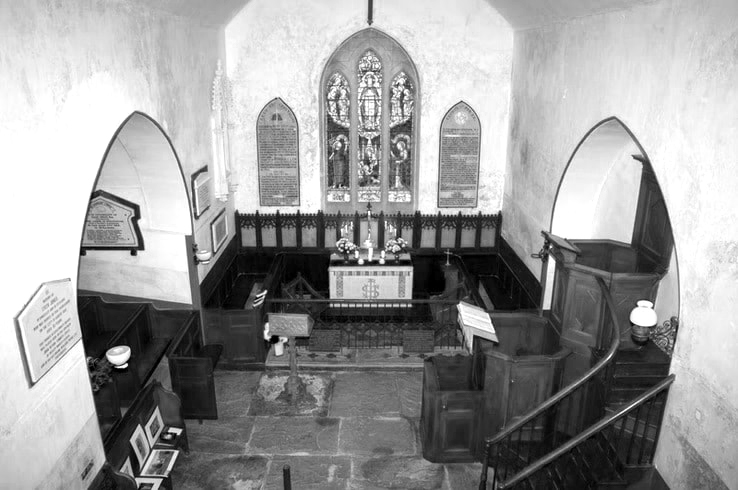
•The First Grave: Dafydd Owen (Dafydd Y Garreg Wen)•
The first and only traditional flat grave described here is that of Dafydd Owen, more popularly known as Dafydd Y Garreg Wen (David of the White Rock) after the small lake and farm occupying land between Morfa Bychan and Borth Y Gest, where he lived. The house survives, but the farmland is now taken up by a holiday park of chalets and caravans. There is some confusion as to his actual date of birth; the records of the National Library of Wales state 1711 or 1712 while the parish records in Gwynedd Archive state January 1711, which is likely a mistake due to the records running quarterly from spring to spring. His father was Owen Humphreys of the parish of Ynyscynhaearn (hence his patronymic surname of Owen) and Gwen Humphreys (nee Roberts), originally of Isallt Fawr, Llanfihangel-Y-Pennant, a little further inland from Pentrefelin. Gwen's father, Robert David (1654-1738) is believed to be a direct descendant of Owain Gwynedd ap Gruffydd (c.1100-1170), the first man to be given the title 'Prince of Wales' and her family had long been known for producing medical practitioners; three of her five brothers became doctors and another a bonesetter. She was also the great aunt of the chemist Robert Isaac Jones, the subject of the third grave of this essay.
Dafydd became a harpist and composer of some note (it is popularly believed that he was blind, however this has been disputed; it is possible he has been confused with two other Welsh harpists, John Roberts and Richard Roberts, who we know for certain were blind). He wrote a number of well-known airs including ‘Codiad yr Ehedydd’ (‘The Rising of the Lark’), and ‘Difyrrwch Gwŷr Criccieth’ (‘The Delight of the Men of Criccieth’). ‘Codiad yr Ehedydd’, as a version arranged by Joseph Haydn ('See O See The Breaking Day'), is played at the cenotaph in London every Remembrance Day on the second Sunday in November. It is said that Dafydd fell asleep on a hillside between Borth Y Gest and Pentrefelin on his way home after a night of merriment and dreamed the melody, woke up and was able to play the tune.
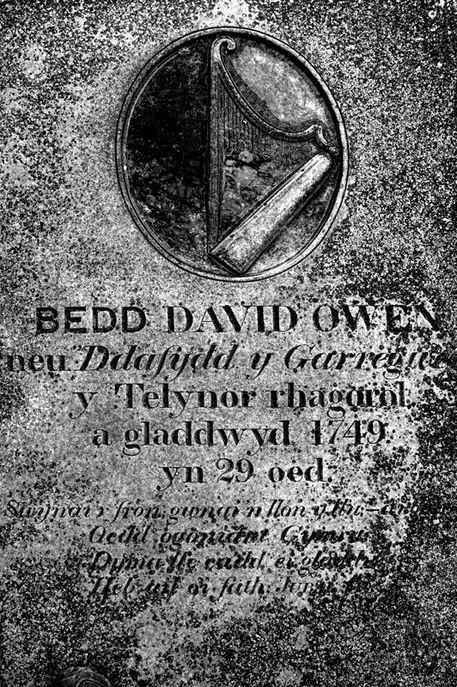
Dafydd died aged 29 years and according to the parish records he was buried in August 1741 (which agrees with a 1712 birthdate). For reasons unknown, however, his flat slate gravestone (erected in 1840), states that he died in 1749. Tradition has it that as he lay dying of an illness, he lapsed into unconsciousness and was thought to be dead. However, he revived and told his wife and mother that he had heard the sweetest tune in heaven. He asked for his harp and then played the sad, slow haunting air since named after him, ‘Dafydd Y Garreg Wen’, requesting that this be played on a solo harp at his funeral. Which it was. As he played the last note, he is said to have died. His simple, flat slate tombstone depicts a harp and tells us in Welsh that he was "a superb harpist" and "the glory of Wales". There is a story that two white doves landed on his grave signifying, in Celtic mythology, that the soul had travelled to the afterlife in peace.
In Scotland, the tune 'Dafydd Y Garreg Wen' is known as 'July Jott' and it is claimed by some that its Scottish roots predate its claimed Welsh origin. We may suspect that Dafydd visited Scotland; either his brother Rhys (also apparently an accomplished harpist), or his cousin (depending on the historical source) lived there and worked as a gardener at Roslin Castle, just south of Edinburgh (now a ruin), and it is said that Dafydd, following rejection by a lover, walked all the way there and back in atrocious weather (although another story has it that he never made it and turned back due the ill-health which later claimed his life). The purported Scottish link is strengthened by the tune ‘Difyrrwch Gwŷr Criccieth’ being named 'Roslin Castle' within Scotland, though the Welsh version has a Welsh lyric written by Ieuan Glan Geirionydd, the pen-name of Evan Evans of Trefriw who, although raised by influential Calvinistic Methodist parents, became an Anglican clergyman as well as a poet. There is a Welsh harp in the Palace of Holyroodhouse, the official residence of the monarch in Scotland, and it has been claimed that this was brought to Scotland by Dafydd's brother (or cousin).
Nevertheless, the 'Dafydd Y Garreg Wen' tune has a distinctly Welsh character and some years after his death the notation was included in Edward Jones’s influential book of 1784, ‘Musical and Poetical Relicks of the Welsh Bards’. In 1803 the Scottish music publisher, George Thompson, who had already gained a reputation for having Robbie Burns’s poetry put to music, commissioned Joseph Haydn to write arrangements for five Welsh airs including ‘Codiad yr Ehedydd’ and ‘Dafydd Y Garreg Wen’. Thompson’s method when commissioning musical arrangements was to allow the composer only the basic melody, without title, history or other knowledge that may influence. In the case of ‘Dafydd Y Garreg Wen’, Haydn’s empathic nature came to the fore; he created a suitably beautiful and melancholic version for violin, cello and piano. The title was later added to the composer’s manuscript and Haydn’s arrangement used as the basis for a further commission of lyrics (in English) to accompany the music. This commission was taken up by the Rev. George Warrington then of Pleasely, Derbyshire, who was later to become vicar at Hope, Flintshire and Canon of St Asaph Cathedral. Later arrangements were written by others including Benjamin Britten for both piano and voice and harp and voice. Sir Walter Scott’s poem the “The Dying Bard” written three years after the original commission, in 1806, was also based on the story of Dafydd on his deathbed.
The words most commonly sung today, usually in the original Welsh, were added to the air by John Ceiriog Hughes, who was born at Pen Y Bryn farm in the hills above the village of Llanarmon Dyffryn Ceiriog in Denbighshire (now part of the county of Wrexham). An avid collector of Welsh folk tunes, he produced many verses for traditional harp music and published a book of such verse in 1863, “Cant O Ganeuon ("A Hundred Songs"), originally intended to be the first of three volumes but unfortunately never completed. He was a poet who insisted on writing with emotional sincerity with a heavy emphasis on the vernacular and because because of this Ceiriog Hughes has been likened to a Welsh Robbie Burns or Samuel Coleridge. A literal English translation of his lyric is:
'Carry', said David, 'my harp to me'
I would like, before dying, to give a tune on her
Lift my hands to reach the strings
God bless you, my widow and children!
Last night I heard an angel's voice like this:
"David, come home and play through the glen!"
Harp of my youth, farewell to your strings!
God bless you, my widow and children!
Another hugely popular collection of work, Henry Brinley Richard's 'Songs of Wales: A Collection of the National Melodies', published 1873, included several of Dafydd's airs. Later, on February 13, 1923, Mostyn Thomas sang ‘Dafydd Y Garreg Wen’ at the opening of the inaugural program broadcast on BBC Radio Wales. Since then the song has been recorded by diverse artists including the tenor Peter Pears, bass-baritone Bryn Terfel, soprano Angharad Gabriel, and rock and folk singer Cerys Matthews.
•The Second Grave: James Spooner•
The next grave, a family affair comprising a more ostentatious mounted urn surrounded by a yew and an ornate railing, is that of James Spooner. Spooner was an Englishman, born at Leigh, near Worcester in 1790, who trained as a land surveyor, working initially for the Ordnance Survey. He first came to Wales in 1818 with his wife Elizabeth, who he had married five years earlier, to survey the route for a railway from the slate quarries in the hills surrounding Blaenau Ffestiniog to the harbour at Portmadoc.
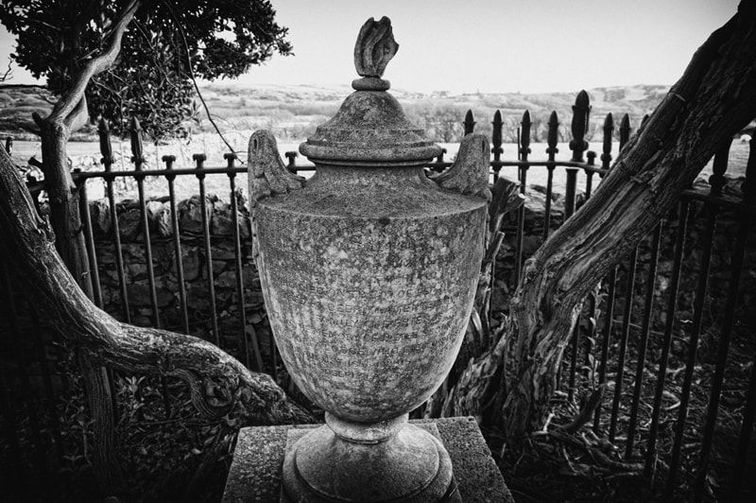
The customary method of transporting the slate was slow and cumbersome. Slate was carried by horse and cart and pack animals over rough tracks to the River Dwyryd where it was loaded onto shallow boats and taken downstream to be loaded onto larger sailing ships capable of traversing the open sea. Carts and animals would then have to make the return journey unladen. The plan was to speed the downward journey by building a free-running gravity fed railway with horse-drawn carriages returning on the rails to the quarries. Spooner surveyed two routes to Portmadoc. The first, completed in 1825, followed three inclines on the western slopes of Moelwyn Mawr and Moelwyn Bach, on a route that later became the Croesor Tramway. The second survey, completed in 1831, was based on a similar route previously proposed by WA Provis in 1825. This was decided upon as the eventual route of the Ffestiniog Railway, which was built between 1832-1836, but only after twice being refused by Parliament. It is now considered to be the oldest independent railway company in the world. Spooner’s route had the slate travelling downward from the individual quarries on two branch-lines which met where the town of Blaenau Ffestiniog exists today. The loaded wagons then descended, entirely by gravity, for nearly 20 km to the harbour at Portmadoc. The route was steep with a number of sharp curves, including one U-bend, and a 20 metre high embankment. Two tunnels were also built. A fully laden downward journey took 1 hour and 40 minutes while the return upward journey, often carrying workers, took almost 6 hours.
James Spooner remained at the Ffestiniog railway for the rest of his life serving as Company Clerk from 1836-1845, overseeing the construction of the railway in conjunction with Thomas Pritchard, an engineer who had previously worked on the Chester to Holyhead line with the pioneering railway engineers, George and Robert Stephenson. He was then Company Secretary until his death in 1856. In the final years of service he investigated the possibility of converting the Ffestiniog operation to using steam locomotives. In what would nowadays be considered a conflict of interest James Spooner was further employed as quarry agent and engineer to the Ffestiniog Railway’s principal customer, the Oakley Quarries, run by Louisa Jane Oakeley, after the death of her husband William Griffith Oakeley in 1835.
William Oakeley had built several slate quays on the River Dwyryd and was himself involved in the creation of the Ffestiniog Railway. Under Louisa Oakeley’s management the nearby town of Blaenau Ffestiniog thrived and she was particularly instrumental in the building of a hospital for the quarry employees. In the following years, however, she started to lose interest in the family business, and became increasingly reclusive. She eventually left the family home at Plas Tan Y Bwlch near Maentwrog to live in a hotel in Shrewsbury with a maid. In 1867 her nephew and heir to the Oakeley quarries, William Edward Oakeley, had her examined by a doctor in order to have her certified insane, without success. A year later, however, she signed over the management, but not ownership, of the estate to him. She died in 1879, having never returned to Wales.
James Spooner’s involvement in the fledgling Ffestiniog railway marked the beginning of a railway dynasty. When James and Elizabeth first came to North Wales they had three small children, Matthew aged four years, James aged two years and Caroline aged one year and continued to have children with astonishing regularity. They resided at Maentwrog for the first six years and during this time had four more children, Charles Easton in 1818, Louisa in 1820, Thomas in 1822 and Amelia in 1824. They then moved to William Maddocks’ (also the founder of nearby Portmadoc) former home at Plas Tan Yr Allt near Tremadoc. Here, one child was born, Elizabeth in 1827.
The romantic poet and Gothic novelist Percy Bysshe Shelley had been a previous tenant in 1812-1813 along with his first wife, Harriet Westbrook, and it was here that he wrote his first lengthy poetic work, 'Queen Mab'. He fled to Ireland owing William Maddocks a considerable sum of money for rent after claiming that an intruder armed with a pistol broke into the house one stormy night and tried to murder him. Shelley later poetically embellished the event, depicting the intruder as a furry and horned apparition gibbering incomprehensibly. He apparently wrestled with the beast and claimed that he took hold of the pistol and threw it out of the window, whereupon the entity vanished. A more mundane explanation for Shelley's rapid departure is that he had continually pestered local farmers to financially support William Maddocks after the embankment in Portmadoc known as the 'Cob' had been heavily damaged by spring tides. He had also taken to frequently walking the hills behind the house armed himself with a pistol and shooting dead any sheep he found which he considered were in poor health, much to the chagrin of the local farmers. They then grouped together to visit Shelley and inform him of their displeasure at his actions and demanding recompense. Another possibility is that the intruder was a government agent looking to kill Shelley and his house guest, an Irishman named Dan Healy, fresh out of Barnstaple Gaol for distributing, at his request, Shelley's seditious pamphlet 'The Declaration of Rights'. Whichever story is true, a government assailant or a posse of local farmers, it is said that in January 1931 Ellen Mabel Williams-Ellis (the mother of the well-known architect and founder of Portmeirion, Bertram Clough Williams-Ellis) then living at Plas Tan Yr Allt, did find a rusted pistol embedded in the roots of a laurel tree while gardening.
A further move saw the family again reside in a home of William Maddocks, Morfa Lodge in Portmadoc, after Maddocks’ death in Paris in 1829 en route from Italy and his subsequent burial at Pere Lachaise Cemetery. This house saw the birth of Harriet in 1830 and William in 1834. Elizabeth died in 1850 and before the year was out Spooner, against the wishes of his children, married a woman named Eliza. After six years of marriage James Spooner himself died on 18th August leaving Eliza Spooner as the sole executor of his will. Although the will stipulated that his estate was to pass in equal part to all children, Eliza refused to comply and somehow managed to inherit the entire estate herself. This was not the only tragedy to befall the family. The same year they moved to Morfa Lodge, 15-year old Matthew accidentally shot his 12-year old sister Caroline, killing her. Five years later, Matthew took his own life in France.
Three of James’s and Elizabeth’s sons had careers involving railways. James Jnr became a railway engineer and worked in Australia for 12 years before returning to Wales to survey the Tal Y Llyn slate quarry railway in 1863. Thomas was a lawyer who acted for the Ffestiniog railway for many years. The Spooner family’s involvement in the Ffestiniog Railway was most notably continued in the work of Charles Easton Spooner, however. Charles had worked initially alongside his father and Thomas Prichard during construction of the rail line and, after working with the finest British engineer of the time, Isambard Kingdom Brunel, returned to Wales in 1847. He was duly appointed Company Treasurer and in 1856, on the death of his father, became Company Secretary, a position he held until 1887 when he was forced to retire due to ill-health. During his tenure, the company laid heavier steel rails to carry it’s first steam locomotives (one of which was named after his father) and the Boston Lodge railway workshops were built. He was a noted author and lecturer on the subject of narrow-gauge railways, and his book, ‘Narrow Gauge Railways’, published in 1871, was considered a standard text. In 1872 the journal 'Engineering' wrote:
"...........he shows an earnestness and enthusiasm, we may almost say an absolute devotion for the Festiniog Railway. More than that, he became famous for his willingness to share his experience with others."
Charles married his wife, Mary in 1848 and although she died twelve years later in 1860, the couple nevertheless had five children. Two of James Spooner’s grandsons also achieved illustrious careers in railways. The eldest, George Percival, born in 1850 had an affair with one of the family’s domestic staff who became pregnant. To save the family embarrassment, he was exiled to India where he eventually became Locomotive Superintendent of the Indian Railways. A younger son, Charles Edwin, born in 1853, qualified as an engineer at Trinity College, Dublin. After working on railways in Wales, he moved to Ceylon in 1876 where he worked as a surveyor. In 1891 he took the position of State Engineer for Selangor in Malaya followed, in 1901, by his appointment as General Manager of the Federated Malay States Railways. Again the Spooner family did not escape tragedy, however. James Alfred, born in 1855, lived for only six weeks, while their daughter Mary Elizabeth, born in 1859 died of either typhoid or bubonic plague in January 1864. Mary’s nurse Elizabeth Preece also contracted the disease and died two days later.
•The Third Grave: Robert Isaac Jones (Alltud Eifion)•
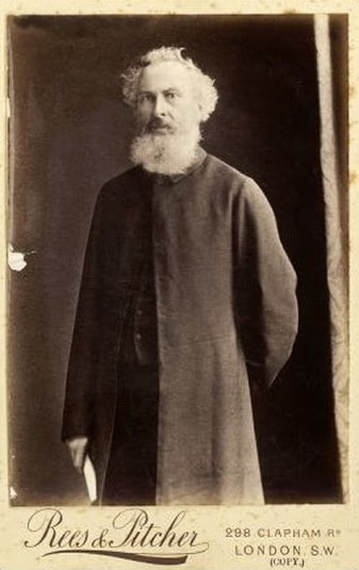
The surprisingly unpretentious grave of Robert Isaac Jones lays to the immediate right as you enter the churchyard. It leans against the rear right side of the lychgate facing the church. About 2 km in a north-north-westerly direction lays Tyddyniolyn, the sixteenth century farmhouse where Robert Isaac was born in 1815, the second of six children, all male, of whom only three lived past their seventeenth birthday. Premature death, of both siblings and offspring, was a common theme in Robert Isaac's life. His elder brother John died in 1819 aged five years while his younger brothers Griffith (aged two years) and Henry (aged sixteen years) died in 1830 and 1842, respectively. All three share the same grave at Ynyscynhaearn. Robert Isaac Jones himself had eight children, outlived six, and enjoyed a longer life than all of them.
Both his father, Owen Jones, and his grandfather, John Jones, were tenant farmers on the influential Price family's Rhiwlas Estate (as became Robert Isaac's sibling Owen, who took over the lease at Tyddyniolyn). Although the bulk of the Estate was located just to the north of Bala, the family owned land across Merionethshire. Tyddyniolyn was later purchased by William Maddocks. His mother, Gaynor (sometimes spelt Gainor) Roberts hailed from Ymwlch, Criccieth and was a member of a family long known for producing sons who became doctors and bonesetters. Robert Isaac Jones was related to Dafydd Y Garreg Wen through his mother; Gaynor's father was Dr Robert Isaac Roberts, the brother of Gwen Roberts, Dafydd's mother. Of Gwen's five male siblings, three became doctors and one a bonesetter. She was also the great-aunt of the chemist Robert Isaac Jones, the subject of the third grave of this essay.
Schooled locally, at about eighteen years of age he became apprenticed to D C Williams, a pharmacist in the nearby town of Pwllheli, thus keeping his mother's family tradition of producing men with trades allied to medicine. Immediately after finishing his training he went to work in the county town of Caernarfon and afterward, for a short while, in London. While apprenticed he started writing poetry, especially englynion, and began entering his work at Eisteddfodau. He won the chair for his ode on the shipwreck of the 'Rothsay Castle', a paddle steamer which ran aground in the Menai Strait in 1816 with the loss of 130 lives. At the inquest, the ship was found to be unseaworthy and the captain drunk. Thus Robert Isaac was admitted to the Gorsedd of Bards and took the name 'Alltud Eifion'. He subsequently published all his written work under this name. Indeed, he became as well-known under this pseudonym and as he was under his real name.
He had originally planned to migrate to Australia after qualifying as a pharmacist but his father persuaded him to stay in Wales and, as a result, he married the first of his three wives in 1838, ironically, the year his father died. He too is buried at Ynyscynhaearn. Elizabeth Hughes was the daughter of Dr Thomas Hughes of Pwllheli. The year following his marriage Robert Isaac became proprietor of the 'Cambrian Pill Depot', located on the east corner of the Market Square in the newly-built town of Tremadoc. There, he manufactured and sold pills and ointments claiming to cure "all manner of ailments......specialising in skin ailments and anti-bilious preparations". and "prepared only by Robert Isaac Jones". He later opened, for a while, a pharmacy at nearby Portmadoc. Throughout the remainder of the nineteenth century, through to the early years of the twentieth, the 'Pill' corner became synonomous with Robert Isaac's pharmacy and he advertised and sold his wares across Wales and parts of England. A slate plaque inscribed 'Robert Isaac Jones, Cambrian Pill Depot, Established 1839' sits in remembrance on the building today.
Robert Isaac and Elizabeth had two sons. The first, born in 1838 was W Robert Jones. For a decade he worked for his father, especially in the Portmadoc store, but eventually left to pursue a medical career. He was clearly an intelligent and hard-working student as he passed his Licentiate in Medicine in Edinburgh in 1873, then gained qualification as a pharmacist at the Apothecaries Hall in London in 1874. He returned to Wales to serve as a doctor at Betws Y Coed but eventually moved to London to marry Celia Elizabeth. He died in Deptford in 1898, aged 60 years. Their second son was born in October 1839 and named Hugh Owen. He lived a little less than three months and died on January 5th 1840. Elizabeth herself died a month later on February 8th, aged just 28 years.
Although Robert Isaac was raised as a Methodist, he joined the (considerably less popular in that part of the world), Anglican Church in 1842. He also became a staunch supporter of the (equally as unpopular) newly-formed Conservative Party. Whether this was due to some re-evaluation of his faith and general outlook on life resulting from the death of his wife and son, or the influence of his second wife, who he had married the previous year, is uncertain. As is why he would want to put himself at odds with the majority of his compatriots. Nevertheless, to their credit, he seems not to have suffered for doing so and he remained an enthusiastic participant in both institutions for the rest of his life. For example, four years after joining the church he, along with Nathanael Mathews, commissioned and purchased from Thomas Cole from Derby, England, the clock which adorns the front spire of Tremadoc church. It was to portend Robert Isaac's continuing mixed fortunes in the years ahead; plenty of enthusiasm with often little actual gain. Although it was installed two years later in 1848 it proved to be a millstone around the congregation's neck due to its unreliability. Sometime in the 1890s Richard Methuen Greaves, owner of the Llechwedd slate quarry at Blaenau Ffestiniog and brother of Ellen Mabel Williams-Ellis, is said to have spent £40 on repairs (equivalent to about £4,300 today) but this appears to have been shortlived. By the late 1970s only the oldest member of the congregation had any memory of it working. In 1977 Dr John Jones Morris and Terry Birch had it repaired again but, because of the unsafe condition of the timber floors, it became unable to be regularly wound. It last worked in 2000.
Robert Isaac's second wife was Martha Roberts, a native of Tremadoc born in 1823. They remained married for 34 years and had six children, five boys and one girl. The first born and arguably most successful career-wise was Isaac Henry (known as 'Harri Bach' to Welsh speakers and 'Little Henry' to English speakers; nicknames which appear to have stuck with him throughout his life). Isaac Henry was born in 1844 and educated at Portmadoc, Beddgelert and Rushley's Grammar School near Chester, England. After deciding on a medical career, initially Isaac Henry became apprenticed to his father's brother, Dr John Jones of Dolwyddelan and later, like his half-brother, W Robert Jones, received his Licentiate from the Royal College of Physicians in Edinburgh in 1866 (though earlier than his brother) as well as a Licentiate in Midwifery and also completed a Licentiate at the Faculty Physicians and Surgeons in Glasgow. He then spent two years as a doctor working for the British Government Emigration Service, on the National Steamship Company's ships plying between London and New York. This was followed by five years as a government surgeon in Madras, India. After becoming seriously ill (ill health was to plague him throughout his life) he took an extended leave, firstly at home in Tremadoc, later returning to New York, where he met his future wife and married her in 1873, resigning his post and remaining in the USA. He was awarded the qualification of MD by Western Case University and became a member of the American Medical Association and the American Public Health Association. After a short time in general practice in New York he moved to Scranton, Pennsylvania, where there were many Welsh émigrés. After 15 more years in general practice he undertook further postgraduate study in New York and finally, in 1889, shifted to San Francisco where he spent the remainder of his career as an ear and eye specialist.
The next two children born to Robert Isaac and Martha were both named Edward. Both died young. The first, born in February 1848 lived for only 10 days. The second, born the following year, died in 1855 aged six years. Robert Isaac's third son to reach adulthood was Robert Humphries Jones. Born in 1851, he too became a doctor, gaining qualifications first at Dick's Veterinary College in Edinburgh, followed by a medical degree in London in 1878. He served for a short time as a doctor in Blaenau Ffestiniog before he too immigrated to the USA. He died in Albany, New York, in 1900, aged 49 years. Two years after the birth of Robert Humphries, Robert Isaac's only daughter, Mary Ellen, was born. She too died prematurely in 1856, aged just three years. She is buried at Ynyscynhaearn in the same grave as the two Edwards.
The final child born and the fourth to reach adulthood did not become a doctor, nor did he move away from Tremadoc, always remaining close to his father. Edward Christmas was born in 1856. He became a printer and worked for his father. It was during his second marriage that Robert Isaac branched out from his pharmaceutical business, starting a Welsh language printing and publishing business in 1854 initially employing two men (and the same year he was instrumental in starting an ‘Ysgol Garpiog’ or ‘Ragged School’, offering free education for destitute children in reading, writing and Bible study). His publishing company specialised in both journals and books covering a diverse range of material including religious tracts, poetry, essays, folklore, mythology, biographies and works of geography.
Of particular note was the journal 'Baner Y Groes', a monthly dealing with church and theological issues published in 1855-56 and 1870-71. Also the more literary minded journal 'Y Brython' (all copies of which are now available on the National Library of Wales website) which he began publishing in 1858 along with Daniel Silvan Evans. Evans was an Anglican priest, then at Llangian, who was previously a lecturer in Welsh at St David's and later to become Professor in Welsh at Aberystwyth University. He was also responsible for publishing both a concise and an extended Welsh dictionary. Like Robert Isaac he too suffered the loss of family; he outlived six of his seven children as well as his wife, who died in a road accident. Initially, 'Y Brython' was published weekly, but after the first year a decision was made to convert to a monthly. In 1860 Evans was forced by his Bishop to relinquish his role as co-editor, leaving Robert Isaac to continue alone. The journal ceased publication in 1863 due to falling sales. The previous year, Robert Isaac lost his mother, aged 73 years.
Among the many books he edited and published are a collection of poems by Eifion Wyn entitled 'Gwaith Barddonol Sion Wyn o Eifion’ (1861); a work by Eben Fardd commemorating the repair of the historically important church at Clynnog Fawr, ‘Cyff Beuno: Sef Awdl ar Adgyweiriad Eglwys Clynnog Fawr’ (1863); a collection of essays and poetry by Ellis Owen Cefnmeusydd, ‘Cell Meudwy: Sef Gweithiau Barddonol a Rhyddieithol’ (1877; which remains in print today) and a collection of Welsh hymns, ‘Yr Emynydd Cristionogol’ (1889).
As well as publishing the work of others, Robert Isaac (as Alltud Eifion) regularly contributed articles to a number of journals and newspapers including ‘Yr Haul’, ‘Y Llan’, and ‘Cymru’. For many years he wrote an historical column for the North Wales Chronicle entitled 'Antiquarian Scraps'. He also authored and published a number of books himself. The best known are a book dealing with the genealogy and history of his mother's family, in which he identified no less than thirty doctors (1884); a short book outlining the life of John Ystumllyn (1888; and who is the subject of the fourth grave in this essay) and a history of the local area,'Y Gestiana' (1892). As a Bard he also maintained an interest in Eisteddfodau and was a prominent member of the organising committee of the Madoc Eisteddfodau in 1851, 1872 and 1887 as well as serving as Vice-Chair of the Snowdonia Valley Eisteddfod in 1877.
In March 1875, Martha succumbed to a long illness and died aged 52 years. Four years later Robert Isaac married for the third time, to a widow, Anne Jones (nee Roberts), originally from Trewalchmai, Anglesey but then residing in Rhyl, where the marriage took place. Despite being declared bankrupt in 1882 (though keeping his business) a Mr R Hughes of Llangynog reported him to be (in a letter to the Editor of 'Yr Herald', after visiting him in late December 1886):
“... yn bartriach 75 mlwydd oed, gyda barf hirlaes, heb fritho dim, a'i wallt hefyd heb newid fawr ar ei liw. Pwt o ddyn byr, heb fod yn dew nac yn denau, ac yn gwisgo gwydrau ydoedd. Yr oedd mor sionc â wiwer, ac yn barablwr rhwydd a diddan.”
English: "75 years old with a long beard with no greying, nor has his hair. A little short man, neither fat nor thin, wearing glasses. He was as nimble as a squirrel and an entertaining speaker."
By the turn of the century, however, Robert Isaac was aging fast, his eyesight was failing and he was now unable to work in either the pharmacy or the print shop. And once again he was faced with considerable debts. Nevertheless, his generosity was still evident. On his 85th birthday he gifted a handsome oak chair to the minister at Ynyscynhaearn Church for use in his chancel. In April 1901, in an effort to keep his business afloat, he formed a short-lived business partnership with Edward Christmas who, later that same year, married Edith Laura Beckett in Harrogate, England. Father and son extended the lease on the Cambrian Pill Depot and added the five adjoining cottages at a cost of £30 per annum. Unfortunately, business had slowed down since it's heyday several decades earlier and the partnership lasted only a little over two and a half years, being dissolved by mutual consent in November 1903. Robert Isaac agreed to take on £32 worth of the debt from the pharmacy, while Edward Christmas took over the printing business and the debts involved.
By this time, Robert Isaac was almost completely blind and becoming increasingly infirm. In early 1904 he wrote to Lord Penrhyn soliciting charity. Penrhyn, who was a personal friend of the then Conservative Prime Minister, Lord Balfour, sent a personal note to Downing Street in April pointing out Jones' service to his local community, as pharmacist, philanthropist and historian, as well as a strong supporter of the Tories and the Anglican church in an electorate that was traditionally either hostile or indifferent to both. Poignantly, Penrhyn ended the letter:
"You will notice that he is 90, so that if you can spare him anything out of the CS [charitable fund] it will not be for long."
Despite the service to his community, Lord Balfour declined to respond until August, refusing any assistance. We know that Robert Isaac's other surviving son, Isaac Henry, was financially comfortable in his retirement near San Francisco but there is no record of any financial help forthcoming. Perhaps father and son had fallen out? Or Robert Isaac was too proud to ask? Ironically, Robert Isaac's father had held the local office of 'Overseer of the Poor' at the time of his death and Robert Isaac himself had served as the local 'Superintendent of Taxes'. In any case, his failed sight and finances did not deflect him from his love for Welsh culture. The month following what can only be described as Balfour's blatant dismissal of his dignity, Robert Isaac attended the Eisteddfod held in Rhyl. He was the oldest Bard in Wales.
Six months later he died. On Tuesday March 7th 1905 he died suddenly after contracting bronchitis, despite having been well enough to attend church two days earlier. According to an article in 'Cymro' his last words were:
".......ac mi ymdrechais ymdrech deg." (and I strived a fair effort.)
He was buried the following Saturday in the grave already occupied by his two sons named Edward, his daughter Mary Ellen and their mother Martha. It was a private ceremony, as per his instructions, attended only by close family and invited friends, including Lloyd Humphries who was employed by Robert Isaac as a as a printer for 32 years. A telegram of condolence was received from San Francisco. A year before he died he had left detailed instructions as to how the ceremony should proceed and these were adhered to. Percy Thomas played his favourite hymn, ‘Blinais ar Afonydd Babel’ on the harmonium and another of his chosen hymns, 'Goleuni yn yr Hwyr' was sung the next day at Ynyscynhaearn and Tremadoc churches. He also left instructions that the more valuable books in his collection be given to the University of Wales.
Isaac Henry was forced out of retirement by the 1906 earthquake in San Francisco. He had invested heavily in property which was destroyed in the earthquake and ensuing fire, causing him a considerable financial loss. Being in ill-health, the burden of work proved too much for him, however, and he died on March 7th (coincidentally the same day as his father) 1909, aged 65 years. Like his father he had remained true to the Anglican Church (in the form of the Episcopal Church in the USA). Nevertheless, his Welsh roots were acknowledged at his funeral and two of the three ministers who attended spoke in Welsh. Edward Christmas took over his father's manufacturing pharmacy, having inherited all his recipes but the business continued to flounder. In 1908, finding himself with liabilities of £455 (today approx. £48,000) and assets of only £40 (today approx. £4,200), along with a legal obligation to pay his stepmother an annuity, 52-year old Edward Christmas was declared bankrupt. He was able to keep his furniture and other personal effects by claiming they belonged to his wife and stepmother. Addressing the court he explained that his failure in business was due to:
"No capital, taking over my late father's liabilities, illness of myself, heavy expenses, and competition in trade."
Edward Christmas died in 1932 aged 76 years. Edith Laura outlived him by a further two decades. She died in 1954 aged 89 years. They are buried in the same grave, immediately in front of Robert Isaac Jones.
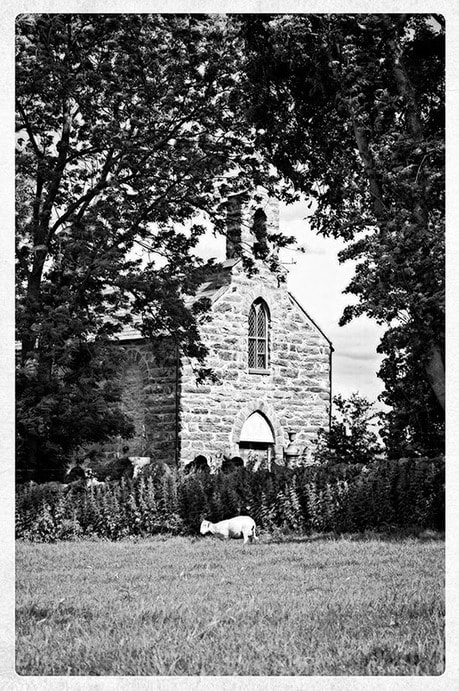
•The Fourth Grave: John Ystumllyn (Jac Black)•
The most humble of the three graves at Ynyscynhaearn is that of Jac (or John) Ystumllyn, or Jac Black as he was popularly known. His is arguably the most extraordinary story of them all. He hailed from the west coast of Africa (though his grave erroneously says India) and was captured by a member of the Wynne family, possibly Ellis Wynne of Maes Y Neuadd, near Talsarnau in a year variously put between 1742 and 1746. Similarly inexact, his age at the time has been put somewhere between eight and thirteen years of age. A portrait of Jac (oil on wood, 22.5 cm x 32.9 cm) dated May 11th 1754 seems to show a young man of about 16 years of age.
He was said to have remembered being captured (apparently not for slavery but as an ‘adventure’), while fishing and hunting moorhens by a stream and to have heard his mother crying out to him when he was taken. On arrival in Wales he was taken to a Wynne family residence at Ystumllyn House whose estate surrounded Ynyscynhaearn church. The house can still be seen from the door of the church. He is said to have had no language but to have been able to utter only screeches and howling noises. It is highly unlikely, however, that he was unable to speak any language and more likely he was simply terrified at finding himself in such a strange place, having been taken away from his people, culture and environment.
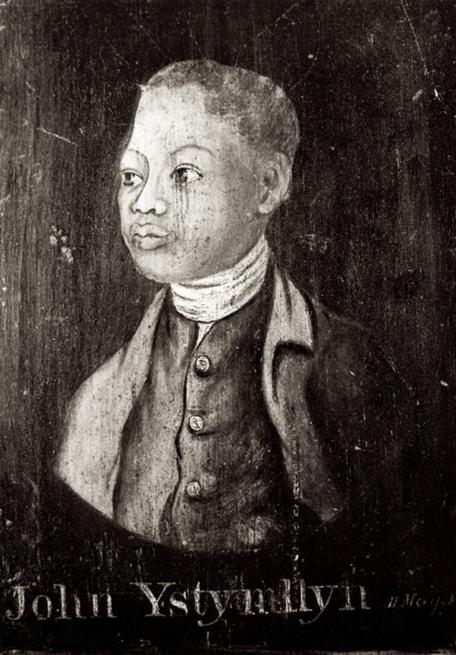
Kept as a servant by the Wynne family and named Jac, he was taught horticulture and employed as the farm's gardener. It is said that he grew to be a very quiet man, kind to others and fond of flowers. He became fluent in both Welsh and English by his late teens, was baptised at Ynyscynhaearn and slowly but surely integrated into the local community. He met his future wife Margaret Margaret Gruffydd, of Hendre Mur, Trawsfynydd at Ystumllyn House, where she worked as a maid. The story goes that when she first set eyes on him she screamed and ran away, as did many children who saw him for the first time! It is said that she was frightened of him for a long time; when he was working in the garden, she would leave his lunch for him in a corner so that she didn't have to talk to him. Eventually, though, they became sweethearts and, after she moved to Dolgellau to work as a maid in the vicarage, John came looking for her and early one morning they both eloped. In 1768 they were married in Dolgellau church and lived at Ynysgain Fawr, where they worked as 'land stewards'.
At some point Jac and Margaret moved to Maes Y Neuadd near Talsarnau to work for William Wynne (later known as William Nanney), then Sheriff of Merionethshire (now Meirionydd). They had seven children whilst there (two of whom died in infancy) and returned to the Ystumllyn estate some years later when, because Jac was in poor health, they were given an ancient thatched cottage, Y Nhyra Isaf, with a garden and a small field. Jac was ill for some time (possibly jaundiced) and died in 1786, probably in his mid to late forties, after confessing on his deathbed that he had sinned by playing the fiddle on the Sabbath. His gravestone, again erroneously, is dated 1790, the year it was believed to have been laid. It is inscribed with a poem, in the style of an englyn, written by Dafydd Sion James of Penrhyndeudraeth:
Yn India gynna'm ganwyd a nghamrau
Yng Nghymru'm bedyddiwyd;
Wele'r fan dan lechan lwyd
Du oeraidd y'm daearwyd.
Which translates as:
India (sic) was the land of my birth,
but I was baptised in Wales;
this spot, marked by a grey slate
is my cold, dark resting place.
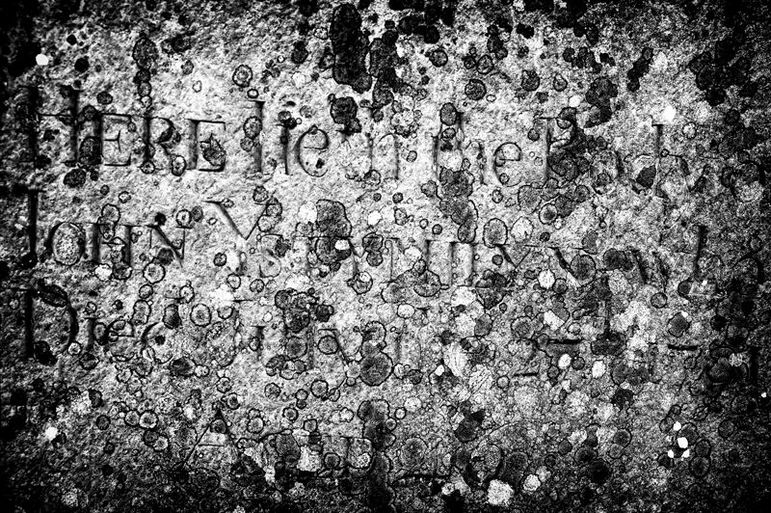
Margaret survived Jac by 42 years and died aged 81 years in 1828. She was apparently physically able all through her old age and did fine sewing and knitting right up to her death. Nevertheless, when in her fifties she was taken advantage of in a most despicable manner. Although Jac and Margaret had been given the title deed to Y Nhyra Isaf she was duped into signing ownership over to Humphrey Jones, a solicitor from Machynllyth, who was gifted the Ystumllyn Estate by his aunt Margaret Moyn Lewis in 1799. The arrangement they came to was that Lewis would be allowed to live out her remaining days on the Estate, in the house known as Bron Y Foel, which she retained the ownership of, and be given an annual stipend from Jones of £400. Jones had originally promised Margaret she could stay in the cottage for the rest of her days for a peppercorn land rent of 6d per year; however he later reneged on this agreement and she ended up paying £1 per year, forty times more than she had agreed, as well as losing the right to use the adjoining field. Humphrey Jones died in 1808 and was succeeded by his son, Humphrey Rowland Jones who, in turn, was succeeded as owner in 1822 by Humphrey Thelwall Jones, the only child by his first marriage to Mary Thelwall. As he was only 14-years old, the Estate was managed by his stepmother Anne. None of these people saw fit to return Margaret's cottage to its former rent-free status. A year before Margaret's death Humphrey Thelwall Jones died while studying at St John's College, Cambridge and ownership of the Ystumllyn Estate, by then heavily in debt, became subject to legal wrangles involving Anne and Jones' seven half-siblings and had to be forcibly sold.
Of Jac and Margaret's children, one daughter, Lowri, married a butler and lived at Madryn. Ann married a Liverpool man, James Martin, a musician who also sold musical instruments, and she died there in old age. Two other daughters, Gwen and Margaret, never married. More is known of their only surviving son, known as Robert Jones. He was employed for 58 years as a gamekeeper and huntsman for Lord Newborough at Glynllifon and lived throughout his adult life at Cae'r Geifr, Llandwrog. He was described as tall and dark and, like his father, had a calm and quiet disposition. He died aged 92 years and, although he expressed a wish to be buried in the same grave as his father he was, for some reason, buried at Llandwrog. Almost certainly there are numerous local residents today with Jac Black’s blood.
Alltud Eifion wrote about Jac’s life story first in a pamphlet entitled ‘John Ystumllyn or Jack Black: The Story of His Life and Tales About Him’ published in 1888, and later in his 1892 book of the history of the area ‘Y Gestiana; A History of Tre’r Gest’, both originally written in the Welsh language. He writes that as a young man Jac was very popular with the ladies and implies that he could have had his pick of several before marrying Margaret. It is interesting to note also that Alltud Eifion makes no mention of any opposition to Jac and Margaret marrying, and the church seem to have had no misgivings in performing the ceremony. Indeed, Jac's best man was Griffith Williams, son of the Rev. Griffiths of Ynyscynhaearn. This seems surprising given that the Church of England at the time was actively involved in the slave trade from West Africa to the West Indies and, at its Codrington plantation in Barbados, owned over 400 slaves, 40% of whom died within three years of arrival. Jac and Margaret's wedding suggests, therefore, that racist attitudes in the Church in Wales at that time were perhaps not as entrenched as those of the parent Church of England or even some Christian quarters in more recent years. Contrast, for example, this attitude from two hundred and fifty years ago with one of the leading Christian colleges in the United States, Bob Jones University who, refused to accept black students until 1971 and even then expelled students who dated people outside of their own race for another 28 years. Similar attitudes prevail in some churches in the Southern states of the USA. The following quote is from the Rev. Dennis Anderson, proudly displayed today on the website of his Appleby Baptist Church in Nacogdoches, Texas:
“I would witness to a Negro as quickly as I would any other race...... However, I am not going to avoid the Scriptures in order to have a Negro in our congregation as many of the brethren do. If a Black couple or family wants to come to our Church they need not expect me to avoid what God says about the Hamite. If an interracial couple wants to come to our assembly they will need to know I will not be silent about their unscriptural union just to keep them. It has nothing to do with being prejudiced; it is a matter of the Bible”.
It is also interesting also to contrast Jac Black's experience in Wales with that of a near contemporary, the (now, at least) prejudicially named Sambo who was brought to Sunderland Point in Lancashire, England in either 1720 or 1736, depending on which source is used. Sambo had been brought from the West Indies and forced to serve as the servant of an unnamed merchant ship’s captain. An article in the Lonsdale Magazine of 1822 describes what happened after the ship docked at Sunderland Point:
"After she had discharged her cargo, he was placed at the inn ... with the intention of remaining there on board wages till the vessel was ready to sail; but supposing himself to be deserted by the master, without being able, probably from his ignorance of the language, to ascertain the cause, he fell into a complete state of stupefaction, even to such a degree that he secreted himself in the loft on the brewhouses and stretching himself out at full length on the bare boards refused all sustenance. He continued in this state only a few days, when death terminated the sufferings of poor Samboo. As soon as Samboo’s exit was known to the sailors who happened to be there, they excavated him in a grave in a lonely dell in a rabbit warren behind the village, within twenty yards of the sea shore, whither they conveyed his remains without either coffin or bier, being covered only with the clothes in which he died."
Unlike Jac, there is no mention of medical help being sought. It is possible that Sambo contracted an infectious disease for which he had no natural immunity, and certainly more likely than the early romanticised version of the tale that he had died of a broken heart due to the absence of his beloved master. Because Sambo was not baptised Christian, he was refused burial in the local churchyard and his shoreline grave was unmarked for at least sixty years until 1796 when the Rev. James Watson, (ironically the brother of the prominent Lancaster slave trader William Watson), and a schoolteacher named Bell raised money from local people for a brass plaque. Rev. Watson wrote the epitaph:
“Here lies
poor SAMBOO
a faithfull NEGRO
who
(attending his master from the West Indies)
DIED on his arrival in SUNDERLAND.
Full sixty years the angry Winter’s Wave
has thundering dafhd this bleak and barren Shore
since SAMBO’S head laid in this lonely GRAVE
lies still and ne’er will hear their turmoil more.
Full many a Sand-bird chirps upon the Sod
And many a moonlight Elfin round him trips
Full many a Summer's Sunbeam warms the Clod
And many a teeming cloud upon him drips.
But still he sleeps -- till the awakening Sounds
Of the Archangel's Trump new Life impart
Then the GREAT JUDGE his Approbation founds
Not on man's COLOR but his WORTH of HEART.”
The grave is only accessible via a narrow track, which crosses a salt marsh and is cut off at high tide. In common with Jac’s grave, there is a mistake; the inscription initially says 'here lies poor Samboo', but later refers to 'Sambo'. The recognised name of the location, however, has become known as 'Sambo's Grave’. The current plaque is a copy of the original, and a further telling contrast of the differences in attitude toward Jac and Sambo. The newer version adds:
“Thoughtless and irreverent people having damaged & defaced the plate, this replica was
affixed. RESPECT THIS LONELY GRAVE”
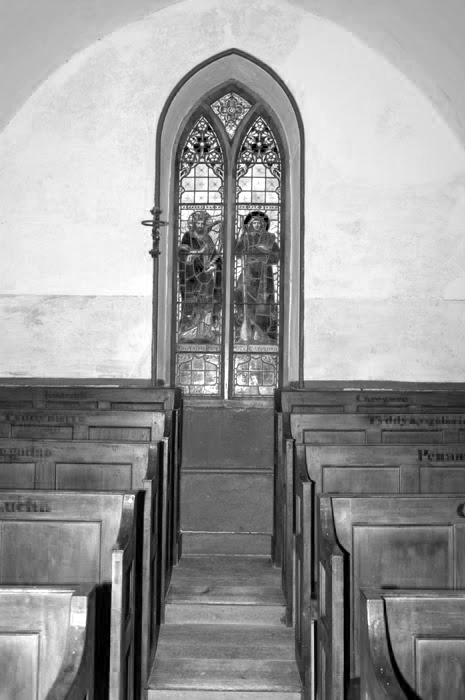
'Four Graves At Ynyscynhaearn'. Original images and written content © Gary Hill 2014. All rights reserved. Not in public domain. If you wish to use my work for anything other than legal 'fair use' (i.e., non-profit educational or scholarly research or critique purposes) please contact me for permission first.

